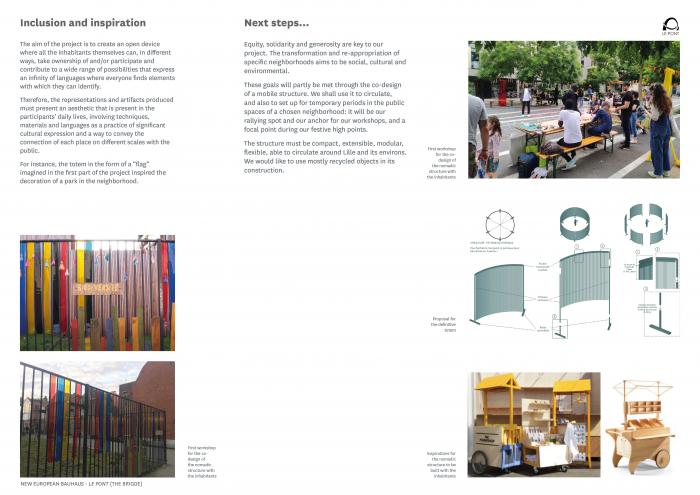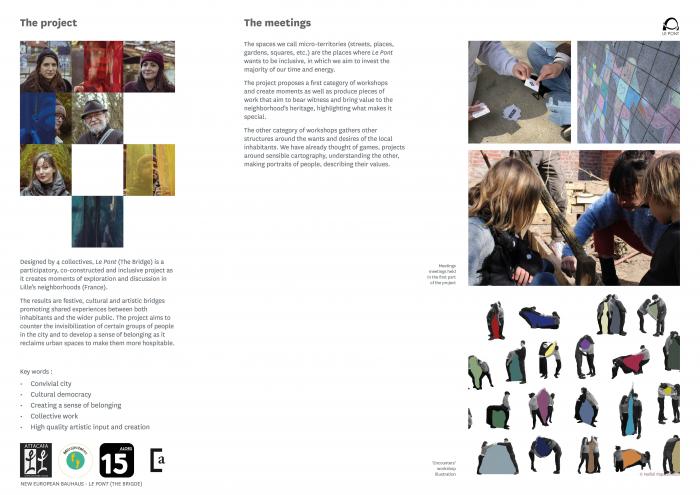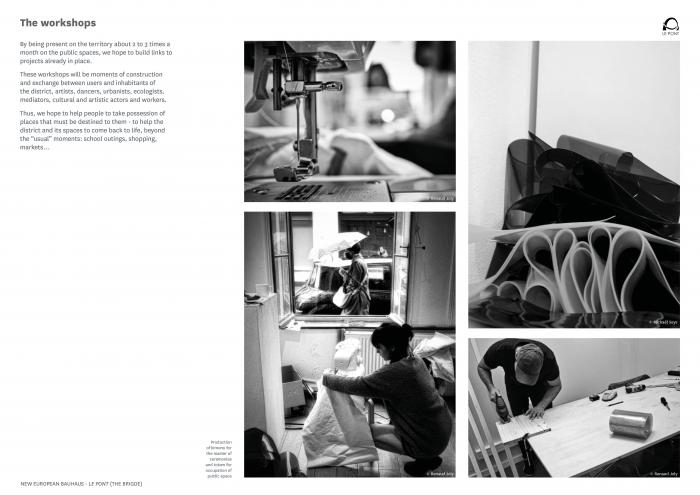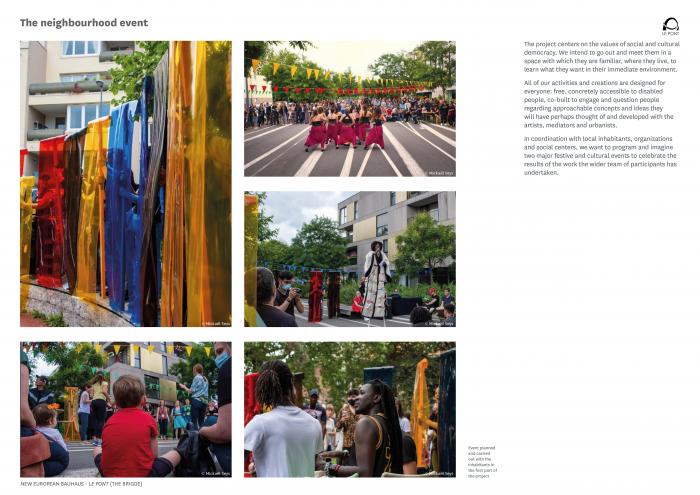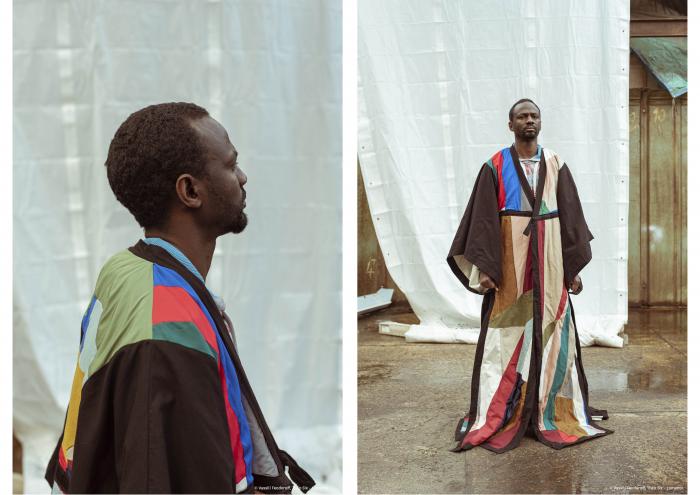Designed by 4 collectives, Le Pont is a participatory, co-constructed and inclusive project as it creates moments of exploration, and discussion in Lille’s neighborhoods. The results are festive, cultural and artistic bridges promoting shared experiences between both inhabitants and the wider public. The project aims to counter the invisibilization of certain groups of people in the city and to develop a sense of belonging as it reclaims urban spaces to make them more hospitable.
In 2019, three organizations based in Lille, Hauts-de-France, co-imagined and co-designed a project called Le Pont (The Bridge). Together, we aim to build bridges between our own different publics, artists, inhabitants and major stakeholders in the territory : district town halls, social centers, popular education organizations, artists from diverse cultural backgrounds or anchored in Lille, local shops and businesses.
The main objective we are targeting with Le Pont is the empowerment of local people. By co-creating the project with the inhabitants of a neighborhood, artists, architects, urbanists, cultural and social mediators, we aim to explore how we can humbly create a new paradigm of the public space together.
Significant values included in this paradigm are environmental, cultural and social sustainability and development. We hope that local populations will regain a sense of belonging to their territory by sharing our resources, tools, experience, knowledge and expertise in various domains. All of this in a cross-domain and sustainable logic. By stepping up exchange between different actors and sectors of the territory and by using open, transparent means of communication, we want to help those living in a devalued, abandoned or stigmatized neighborhood to consider and value the wealth of their culture as we highlight the heterogeneity of public urban spaces in Lille. By building bridges both metaphorically and literally, we also hope to counter the invisibilization of people, communities and help them regain a sense of power over their local area.
Please highlight how the concept/idea can be exemplary in this context
Equity, solidarity and generosity are key here. The transformation and re-appropriation of specific neighborhoods aims to be social, cultural and environmental. Le Pont is an ever-evolving social and cultural experimentation with local inhabitants. It aims to be a driver of change and exchange in the neighborhoods in which we are working.
The above-mentioned goals will partly be met through the co-conception and co-creation of a mobile structure. We shall use it to move around, and also to set up for temporary periods in the public spaces of the neighborhood where we are working: it will be our rallying spot and our anchor.
These spaces will also be those in which we have developed links with people through workshops. We shall invite people of all ages, social and cultural backgrounds, considering them as key skilled contributors on a par with the collective and actors which initiated the project. Horizontal organization means acquiring trust among everyone, and creating moments of discussion and sharing.
The structure we build will be sustainable since we intend to lend it to anyone who would like to use it. The spaces we call micro-territories (streets, places, gardens, squares, etc.) are the places where Le Pont wants to be inclusive, in which we aim to invest the majority of our time and energy. In that regard, we are designing a nomad and autonomous structure together in view of democratizing art and design, and to encourage the re-enchantment, appropriation and multiplication of new possible uses of otherwise underused or neglected public spaces.
We shall co-construct the nomad vehicle, a gathering point for our programming committees. This vehicle will be the focal point during workshops designed to encourage the appropriation and multiplication of new possible uses of public space (cooking, cinema, dance and art workshops to name a few). The structure must be compact, extensible, modular, flexible, able to circulate around Lille and its environs.
Please highlight how the concept/idea can be exemplary in this context
The aim of the project is to create an open device where all the inhabitants themselves can, in different ways, take ownership of and/or participate and contribute to - we are not looking for unique answer - a wide range of possibilities that express an infinity of languages where everyone finds elements with which they can identify.
Therefore, the representations and artifacts produced must present an aesthetic that is present in the participants' daily lives, involving techniques, materials and languages as a practice of significant cultural expression and a way to convey the connection of each place on different scales with the public.
For its aesthetic line, the nomadic structure (which is, by definition, co-constructed) will be developed in consultation with the inhabitants, the collective 15Alors and the visual artist Nefeli Papadimouli, a graduate of the ENSBA Paris. Her work, described as "poetic structuralism", involves the creation of forms that question the society in which we live and its paradoxes: difference and resemblance, union and opposition are all concepts that she observes and transcribes in her artworks. The artist creates performative and relational objects that force bodies to communicate and to stage themselves, while inviting us to consider the physical distance we have with others as a necessity for social balance. Aesthetically, Nefeli Papadimouli's creations convoke the worlds of fashion and architecture, while using recycled materials and everyday objects.
Le Pont (The Bridge) is inspired by vernacular design, as a method for creation that can guide us toward more sustainable, adaptable and inclusive practices. It means we can adopt and incorporate everyone's “shared” ideas in the conceptual/constructive processes, applying them in principles such as constraint, thrift and durability.
Please highlight how the concept/idea can be exemplary in this context
Lille-Sud, the neighborhood where the project will first be taking place, is historically and culturally marked by immigration and poverty. Very socially diverse, it also is enclaved. It falls within the parameters of "Politiques de la ville" and major urban renovations in this part of the city has been ongoing for about a decade. They are taking time and, even though they are principally aimed at local inhabitants, they are also designed to attract more middle class segments of society. We believe that building and renovating a district is not enough for local populations to feel that their voice is heard and nor for them to be seen.
In terms of inclusion, the project centers on specific values. We aim to include a public which often finds itself excluded from cultural activities. We intend to go out and meet in a space with which they are familiar, to learn what theirs want are in their immediate environment. All of our activities and creations are designed for everyone: free, concretely accessible to disabled people, co-built to engage and question people regarding approachable concepts and ideas they will have perhaps thought of and developed with the artists, mediators and urbanists. By imagining our concept in an urban space which we shall have studied and reached out to, we hope that everyone will have an opportunity to take a part in the project. In coordination with local inhabitants, organizations and social centers, we want to program and imagine two major festive events to celebrate the results of the work the wider team of participants has undertaken.
With the input and help of an associated artist, there will be a first category of workshops: to create moments as well as produce pieces of work that aim to bear witness and bring value to the neighborhood’s heritage, highlighting what makes it special. The other category of workshops gathers other structures around the needs and desires of the local inhabitants (see pictures).
Please highlight how this approach can be exemplary
These three dimensions (sustainability, inclusion, aesthetics) are the basis of our project - our common binding values are: co-construction, cultural democracy, the re-appropriation of territory through the sharing and contribution of diverse artists and populations.
More concretely, the way we do this are also a basis linking these three dimensions. Our presence in the territory from spring, 2 to 3 times a month, in the public space, by joining existing projects via neighborhood associations, by exchanging with the latter, to invite the inhabitants to make bridges with us, we hope to build a multitude of links with the public. This should allow us to integrate with our participants, to co-construct urban furniture, for example, to get to know each other, to create in the public space, to write, to program varied types of mini-events in these places.
These workshops will be moments of construction and exchange between users and inhabitants of the district, artists, dancers, urbanists, ecologists, mediators, cultural and artistic actors and workers, all gathered around the goals mentioned before: in a specific aesthetic linked to the chosen artists, keeping in mind a specific leitmotif and themes, we hope to contribute towards the participants taking ownership of places that should be designed for them - to help bring life back to the district and its spaces , beyond the "usual" public moments: school outings, shopping, markets…
Le Pont is based on specific values, which target social mixing and appropriation of public spaces. It is not the type of action we usually see or organize. Bringing us together in this way, and combining our expertise, with certain types of public, certain inhabitants, artists, urbanism, popular education, it is also a way to give ourselves strength together to build something more perennial, a scheme that would allow everyone to appropriate the keys of this ambitious but important project.
The Bridge is based on specific values, which target social mixing and the appropriation of public space. It is not the type of action we usually see or organize. Bringing us together in this way, and combining our expertise, with certain publics, certain inhabitants, artists, urbanism, popular education or links with others... It is also to give ourselves strength together in order to build something more perennial, a scheme that would allow everyone to appropriate the keys of this ambitious but important project.
For instance, during the first part of the project, we held several (informal) meetings with the inhabitants, including the organization of a neighborhood get-together. Discussing the format of this event, many people suggested the idea of a parade through the streets to animate and invite the public, before arriving at the square where we would do all the other activities. A totem in the form of a “flag” was imagined to accompany this parade. Months later, we noticed that the same material used for the totem had inspired the decoration of a park we passed through – thus confirming the approval and appropriation of the work by the inhabitants.
So that the latter can reappropriate the public spaces that are theirs and that are for the time being mostly neglected we hope to re-enchant these spaces, occupying them, say something about them, in ways that we do not often see. Simple appropriation is the originality of the project.
In the next two years, we will develop the project in the following way:
By this summer, the mobile structure we have been talking about will be built and usable by everyone. Throughout the two years, about two to three times a month, we will go to meet the inhabitants with forms of workshops that will evolve according to their desires.
The goal is to form a real programming committee with a team of volunteers, in order to represent the desires of the neighborhood as to what they wish to see, listen to, and feel in their public places. By then, we will be identifiable by the inhabitants in the neighborhood - both with the mobile structure and with our totem works.
The workshops will be built on the values mentioned earlier. Divided into two categories: the long-term ones with the artists who will have participated in the reflection around collective artistic practices, over the two years.
The other category will include everyone, and will be made in the line of the first ones, with practices a little more diverse and taking into account less specific forms of meeting between the participants: games, reflections, debates, exchanges, walks, film projections, visits, etc.
We will do all this keeping in mind that our first objective is to provoke encounters, to go in contact with people. It is also necessary to mobilize the social centers, the associations, in order to create this committee that we were talking about earlier, and to develop a sensitivity to public space, to hospitality.
The programming of highlights in the public space, with very clear-cut choices representing the sensibilities of the collective will, we hope, break down clichés and invite people to meet. In parallel, we will carry out a long-term work on the communication at the local or global level and on the social networks.
We want to keep a real trace of this important project in people's memories and in the public space.
If the project is awarded, we would focus on the quality of the workshops and the mobile structure that we will use over the two years. We are also thinking a lot about the development of the traces we will leave on the territory.
First of all, the video: we think it is necessary to keep a real qualitative trace of this unique project on the territory. Thus, inviting young artists or video makers to participate in the project could be interesting.
Also, if we set up this project, it is because we have faith in our methodology of work, construction and sharing, our way of communicating between collectives and with the inhabitants. Thus, to create a document, an application or a site presents this methodology and way of work in a shareable way, exchangeable for other projects would be a dream. Working with young communication professionals who would share their skills with the team of participants could be interesting. Working with the artists, too, so that the aesthetic part of Le Pont stays alive and well.
Keeping traces, both in the public space and on the internet, in people's minds, is what we would focus on if we had the prize. Finally, we could use all these tools developed in the two years in Lille-Sud and Wazemmes to go and meet another neighborhoods, other cities, with other people who have different wants and reflections around their public and shared spaces.
@Marie, 2022
Content licensed to the European Union.
